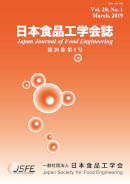
- Issue 4 Pages 131-
- Issue 3 Pages 81-
- Issue 2 Pages 23-
- Issue 1 Pages 1-
- |<
- <
- 1
- >
- >|
-
Shuichi YAMAMOTO2019 Volume 20 Issue 3 Pages 81-97
Published: September 15, 2019
Released on J-STAGE: October 01, 2019
JOURNAL FREE ACCESSMechanistic modeling/simulation is quite important and useful for understanding, designing and operating various food processes. However, the rigorous mathematical/mechanistic models are complicated. It is also difficult and time-consuming to determine the parameter values needed for the simulation. Simplified mechanistic models are useful both for the process understanding and for the parameter value determination. In this paper, simplified mechanistic models for two food processes, drying of liquid foods and chromatography of proteins and food materials, are presented. Both of them are diffusion-controlled processes. A short-cut method for determining the water-concentration dependent diffusion coefficient from isothermal drying rates is described. Factors affecting the drying rates and the inactivation of enzyme are explained based on the simplified model. For chromatography separation processes, a method for determining HETP from linear gradient elution (LGE) curves is explained. Then, how to tune separation performance in LGE is described based on the non-dimensional group (Yamamoto number). The productivity calculation methods based on the simplified model is also explained. The usefulness of a non-dimensional group for describing the dynamic binding capacity of the breakthrough curve for capture chromatography is also discussed.
View full abstractDownload PDF (11659K)
-
Joao CARDOSO, Noriko YOSHIMOTO, Shuichi YAMAMOTO2019 Volume 20 Issue 3 Pages 99-105
Published: September 15, 2019
Released on J-STAGE: October 01, 2019
JOURNAL FREE ACCESSThermodynamic analysis of chromatography separation is important not only for optimization of separation but also development of new separation media and processes. In this study temperature dependence in the separation of two model components (polyphenols) by polymer-based chromatography with ethanol-water mobile phase was analyzed by van’t Hoff plots and isothermal titration calorimeter (ITC). The distribution coefficient K obtained by the isocratic elution of chromatography was employed both for van’t Hoff plots and for the calculation of adsorbed amount in the ITC measurements. Enthalpy values obtained by both methods were similar. As ITC is not able to predict separation behavior, it is recommended to use chromatography experiments as a complimentary method for analyzing the temperature dependence of separation.
View full abstractDownload PDF (2150K) -
Takashi KOBAYASHI2019 Volume 20 Issue 3 Pages 107-113
Published: September 15, 2019
Released on J-STAGE: October 01, 2019
JOURNAL FREE ACCESSAnalog output from the HPLC detector was digitized using a single-board computer (SBC), and the processed data were distributed through a local area network by using the SBC as a web server. Results for the HPLC analysis of coconut oil was recorded on a client computer (PC). The output from two SBCs could be processed simultaneously in real time using a single PC. This system was also applied to the recording of temperature and relative humidity at a remote location. Data were acquired through the internet using a slower connection. Temperature and humidity could be recorded without their loss for three months by setting the acquisition interval longer.
View full abstractDownload PDF (712K) -
Shuji ADACHI, Yayoi MIYAGAWA, Hidefumi YOSHII2019 Volume 20 Issue 3 Pages 115-119
Published: September 15, 2019
Released on J-STAGE: October 01, 2019
JOURNAL FREE ACCESSThe concentrated aqueous residues from the recovery process of useful oil-soluble components from Isada krill were examined by freezing-thawing technique. The aqueous residue was completely frozen into spheres or cuboids of different sizes at −20℃ or −80℃, and then thawed at room temperature (26±2℃). The concentration index was defined as the ratio of the Brix concentration of the melted solution to that of the original solution. The changes in the cumulative fraction and concentration index of melted solution during the thawing process were measured. The freezing temperature had no significant effect on the thawing process. For all the frozen samples, the relationship between the cumulative fraction and concentration index of the melted solution was roughly represented by a single straight line, and the concentration index of the solution obtained by thawing half of the frozen sample was about 1.4. It was shown that the original solution could be concentrated twice when the freezing-thawing operation was repeated twice. However, further repeated operation had no effect on concentration.
View full abstractDownload PDF (1181K) -
Shuji ADACHI, Yayoi MIYAGAWA, Hidefumi YOSHII2019 Volume 20 Issue 3 Pages 123-128
Published: September 15, 2019
Released on J-STAGE: October 01, 2019
JOURNAL FREE ACCESSConditions were examined to prepare a seasoning with shrimp-like flavor from the aqueous residues formed after the recovery of oil-soluble functional components in Isada krill caught from the Sanriku coast in 2017 and 2018 upon treatment under subcritical water conditions. Treatment at ≥160℃ increased the amount of insoluble material and decreased the concentration of soluble matter. The color of the aqueous residue depended on the year of the catch, and the color after treatment under subcritical water conditions was also different. However, when treated under subcritical water conditions, both aqueous residues obtained from the 2017 and 2018 catches showed a decrease in the fishy odor and an increase in fragrant and burnt aromas. The preference score obtained for the residue obtained from the 2017 catch increased after the treatment process. On the other hand, the aqueous residue obtained from the 2018 catch, which did not show any improvement in the preference score upon treatment, was improved when diluted 2 or 4 times after the treatment process. GC-MS analysis revealed that pyridines and pyrazines related to shrimp-like flavor were produced in both aqueous residues obtained from the 2017 and 2018 catches upon treatment under subcritical water conditions.
View full abstractDownload PDF (757K)
- |<
- <
- 1
- >
- >|